Healthcare Management Term Paper: Perceptions and Applications
VerifiedAdded on 2023/01/19
|9
|2386
|20
Report
AI Summary
This report examines key aspects of healthcare management, focusing on the application of "Life Lessons" to real-world scenarios. The paper analyzes two specific life lessons related to workplace dynamics and performance appraisal, drawing from the provided course texts and external sources. It presents two scenarios, one illustrating the negative impact of labeling and stereotyping on employee motivation and organizational reputation within a healthcare setting, and another highlighting the challenges of performance appraisal systems and the importance of fair evaluation. The report also addresses the student's evolving perceptions of healthcare management, comparing their views before and after taking the HSC 520 course, and outlining plans to utilize the learned concepts in their future professional endeavors. The analysis incorporates ethical considerations, leadership principles, and the significance of employee development within the healthcare industry.
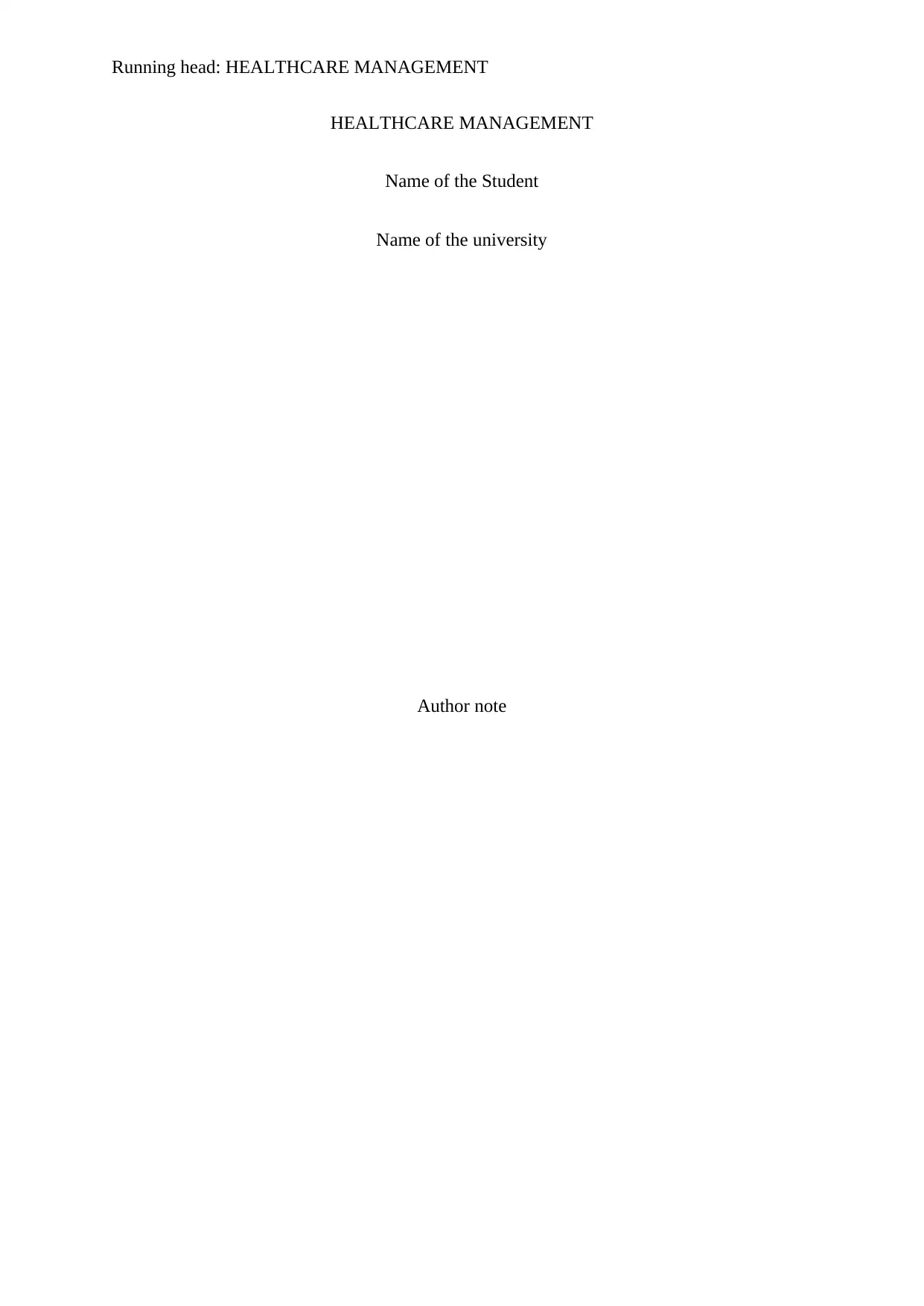
Running head: HEALTHCARE MANAGEMENT
HEALTHCARE MANAGEMENT
Name of the Student
Name of the university
Author note
HEALTHCARE MANAGEMENT
Name of the Student
Name of the university
Author note
Paraphrase This Document
Need a fresh take? Get an instant paraphrase of this document with our AI Paraphraser

1HEALTHCARE MANAGEMENT
2nd life lesson: Be slow to put negative labels on those with whom you work. Labels are
too often demeaning, and worse, self-fulfilling!
It is the nature of human being to characterize individuals along with putting them
into categories. When an individual labeled to be difficult, the level is used for predicting the
behavior as well as action in the immediate as well as long-term future. Alternately it can be
said that the labels create expectation about the behavior of the specific individual (Cundiff &
Vescio, 2016). When it comes to labeling employees on the basis of their performance and
personality, it has the potential to impose highly negative impact on the productivity and
reputation of the organization. Labeling in the workplace can result in treating an individual
based on the preconceived notion. This may often leads to injustice, unethical behavior, abuse
as well as mistreatment. Stereotyping an employee or a group of employee as problem
employee points out the lack of appropriate leadership in the organization. Stereotyping in the
workplace is making assumptions about people based on a person's gender or culture, or is
based on religious or physical attributes (Lyons et al., 2015). Although some stereotyping
may be done innocently or in jest, the risk is hurting people's feeling and creating a work
environment in which people feel discriminated against.
Scenario 1
In this scenario, the impact of labeling employees in the XYZ healthcare home has
been discussed. It has been seen that majority of time labeling employees has led to
generalization as well as unfair assumption. The XYZ healthcare home is a new healthcare
home and the aim of the same is to serve the local community. The total number of
physicians in the organization is currently 4 and the total number of nurses in the
organization is 34. The management of the XYZ healthcare home is trying to provide its best
service to its consumers.
2nd life lesson: Be slow to put negative labels on those with whom you work. Labels are
too often demeaning, and worse, self-fulfilling!
It is the nature of human being to characterize individuals along with putting them
into categories. When an individual labeled to be difficult, the level is used for predicting the
behavior as well as action in the immediate as well as long-term future. Alternately it can be
said that the labels create expectation about the behavior of the specific individual (Cundiff &
Vescio, 2016). When it comes to labeling employees on the basis of their performance and
personality, it has the potential to impose highly negative impact on the productivity and
reputation of the organization. Labeling in the workplace can result in treating an individual
based on the preconceived notion. This may often leads to injustice, unethical behavior, abuse
as well as mistreatment. Stereotyping an employee or a group of employee as problem
employee points out the lack of appropriate leadership in the organization. Stereotyping in the
workplace is making assumptions about people based on a person's gender or culture, or is
based on religious or physical attributes (Lyons et al., 2015). Although some stereotyping
may be done innocently or in jest, the risk is hurting people's feeling and creating a work
environment in which people feel discriminated against.
Scenario 1
In this scenario, the impact of labeling employees in the XYZ healthcare home has
been discussed. It has been seen that majority of time labeling employees has led to
generalization as well as unfair assumption. The XYZ healthcare home is a new healthcare
home and the aim of the same is to serve the local community. The total number of
physicians in the organization is currently 4 and the total number of nurses in the
organization is 34. The management of the XYZ healthcare home is trying to provide its best
service to its consumers.
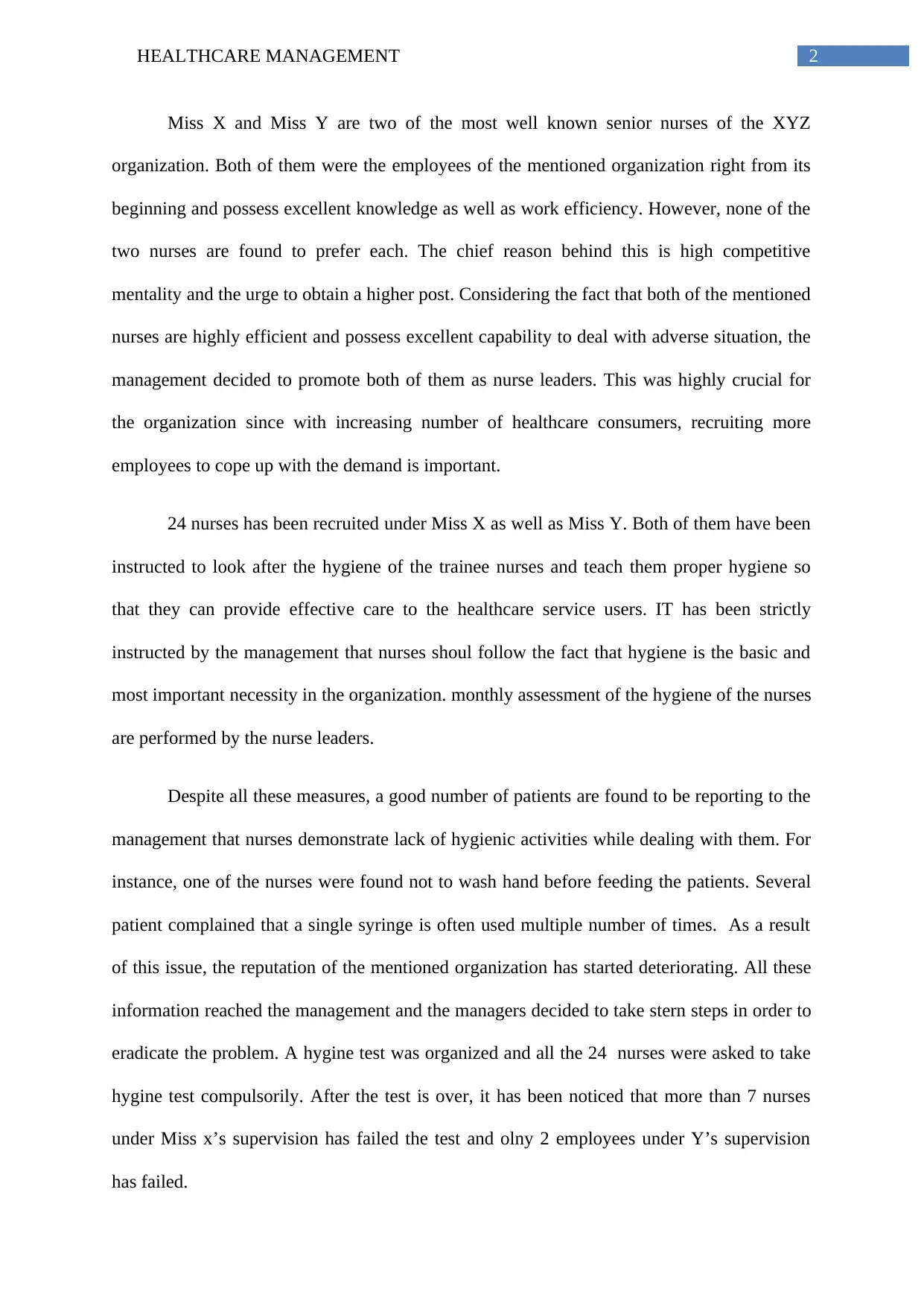
2HEALTHCARE MANAGEMENT
Miss X and Miss Y are two of the most well known senior nurses of the XYZ
organization. Both of them were the employees of the mentioned organization right from its
beginning and possess excellent knowledge as well as work efficiency. However, none of the
two nurses are found to prefer each. The chief reason behind this is high competitive
mentality and the urge to obtain a higher post. Considering the fact that both of the mentioned
nurses are highly efficient and possess excellent capability to deal with adverse situation, the
management decided to promote both of them as nurse leaders. This was highly crucial for
the organization since with increasing number of healthcare consumers, recruiting more
employees to cope up with the demand is important.
24 nurses has been recruited under Miss X as well as Miss Y. Both of them have been
instructed to look after the hygiene of the trainee nurses and teach them proper hygiene so
that they can provide effective care to the healthcare service users. IT has been strictly
instructed by the management that nurses shoul follow the fact that hygiene is the basic and
most important necessity in the organization. monthly assessment of the hygiene of the nurses
are performed by the nurse leaders.
Despite all these measures, a good number of patients are found to be reporting to the
management that nurses demonstrate lack of hygienic activities while dealing with them. For
instance, one of the nurses were found not to wash hand before feeding the patients. Several
patient complained that a single syringe is often used multiple number of times. As a result
of this issue, the reputation of the mentioned organization has started deteriorating. All these
information reached the management and the managers decided to take stern steps in order to
eradicate the problem. A hygine test was organized and all the 24 nurses were asked to take
hygine test compulsorily. After the test is over, it has been noticed that more than 7 nurses
under Miss x’s supervision has failed the test and olny 2 employees under Y’s supervision
has failed.
Miss X and Miss Y are two of the most well known senior nurses of the XYZ
organization. Both of them were the employees of the mentioned organization right from its
beginning and possess excellent knowledge as well as work efficiency. However, none of the
two nurses are found to prefer each. The chief reason behind this is high competitive
mentality and the urge to obtain a higher post. Considering the fact that both of the mentioned
nurses are highly efficient and possess excellent capability to deal with adverse situation, the
management decided to promote both of them as nurse leaders. This was highly crucial for
the organization since with increasing number of healthcare consumers, recruiting more
employees to cope up with the demand is important.
24 nurses has been recruited under Miss X as well as Miss Y. Both of them have been
instructed to look after the hygiene of the trainee nurses and teach them proper hygiene so
that they can provide effective care to the healthcare service users. IT has been strictly
instructed by the management that nurses shoul follow the fact that hygiene is the basic and
most important necessity in the organization. monthly assessment of the hygiene of the nurses
are performed by the nurse leaders.
Despite all these measures, a good number of patients are found to be reporting to the
management that nurses demonstrate lack of hygienic activities while dealing with them. For
instance, one of the nurses were found not to wash hand before feeding the patients. Several
patient complained that a single syringe is often used multiple number of times. As a result
of this issue, the reputation of the mentioned organization has started deteriorating. All these
information reached the management and the managers decided to take stern steps in order to
eradicate the problem. A hygine test was organized and all the 24 nurses were asked to take
hygine test compulsorily. After the test is over, it has been noticed that more than 7 nurses
under Miss x’s supervision has failed the test and olny 2 employees under Y’s supervision
has failed.
⊘ This is a preview!⊘
Do you want full access?
Subscribe today to unlock all pages.

Trusted by 1+ million students worldwide
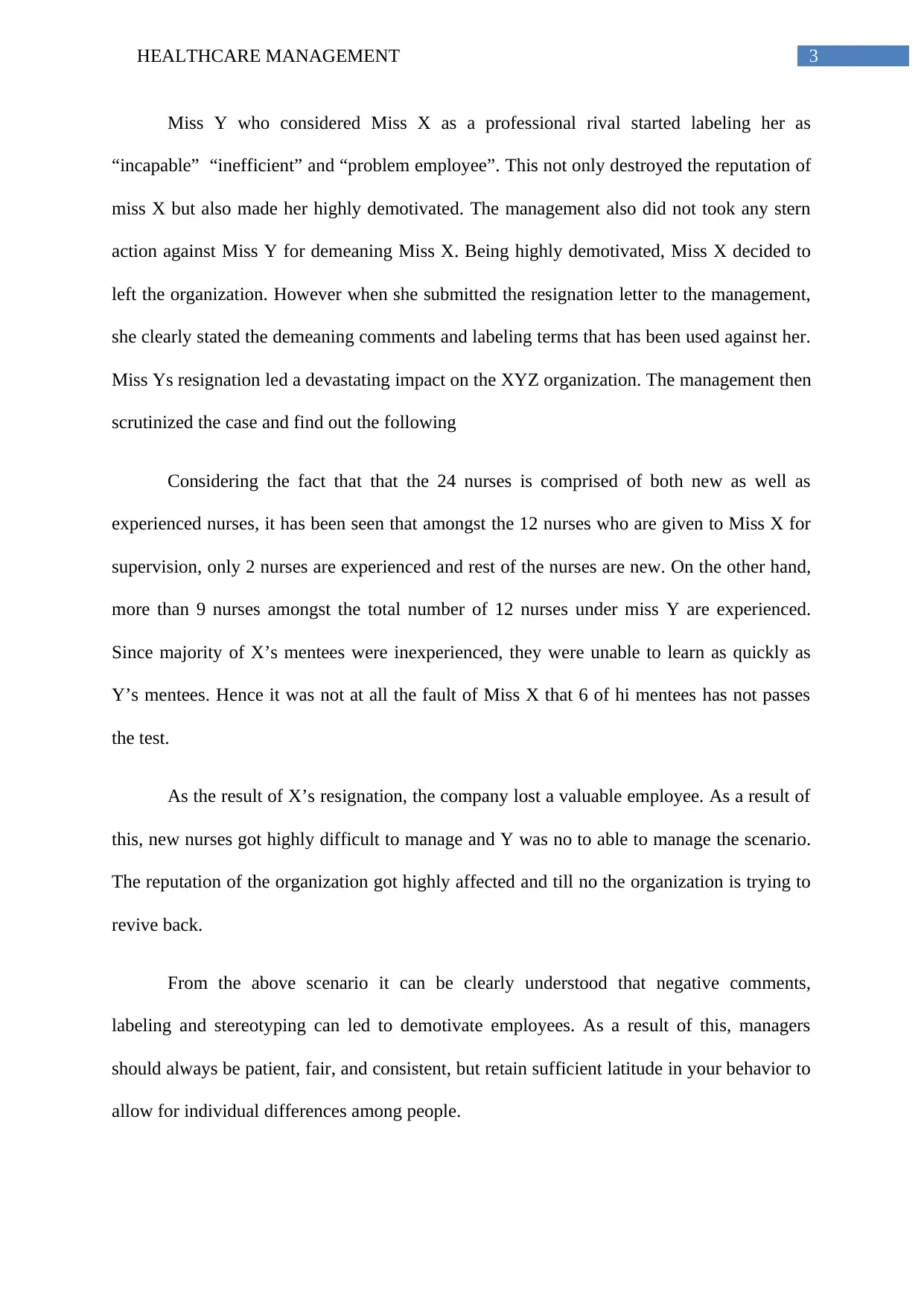
3HEALTHCARE MANAGEMENT
Miss Y who considered Miss X as a professional rival started labeling her as
“incapable” “inefficient” and “problem employee”. This not only destroyed the reputation of
miss X but also made her highly demotivated. The management also did not took any stern
action against Miss Y for demeaning Miss X. Being highly demotivated, Miss X decided to
left the organization. However when she submitted the resignation letter to the management,
she clearly stated the demeaning comments and labeling terms that has been used against her.
Miss Ys resignation led a devastating impact on the XYZ organization. The management then
scrutinized the case and find out the following
Considering the fact that that the 24 nurses is comprised of both new as well as
experienced nurses, it has been seen that amongst the 12 nurses who are given to Miss X for
supervision, only 2 nurses are experienced and rest of the nurses are new. On the other hand,
more than 9 nurses amongst the total number of 12 nurses under miss Y are experienced.
Since majority of X’s mentees were inexperienced, they were unable to learn as quickly as
Y’s mentees. Hence it was not at all the fault of Miss X that 6 of hi mentees has not passes
the test.
As the result of X’s resignation, the company lost a valuable employee. As a result of
this, new nurses got highly difficult to manage and Y was no to able to manage the scenario.
The reputation of the organization got highly affected and till no the organization is trying to
revive back.
From the above scenario it can be clearly understood that negative comments,
labeling and stereotyping can led to demotivate employees. As a result of this, managers
should always be patient, fair, and consistent, but retain sufficient latitude in your behavior to
allow for individual differences among people.
Miss Y who considered Miss X as a professional rival started labeling her as
“incapable” “inefficient” and “problem employee”. This not only destroyed the reputation of
miss X but also made her highly demotivated. The management also did not took any stern
action against Miss Y for demeaning Miss X. Being highly demotivated, Miss X decided to
left the organization. However when she submitted the resignation letter to the management,
she clearly stated the demeaning comments and labeling terms that has been used against her.
Miss Ys resignation led a devastating impact on the XYZ organization. The management then
scrutinized the case and find out the following
Considering the fact that that the 24 nurses is comprised of both new as well as
experienced nurses, it has been seen that amongst the 12 nurses who are given to Miss X for
supervision, only 2 nurses are experienced and rest of the nurses are new. On the other hand,
more than 9 nurses amongst the total number of 12 nurses under miss Y are experienced.
Since majority of X’s mentees were inexperienced, they were unable to learn as quickly as
Y’s mentees. Hence it was not at all the fault of Miss X that 6 of hi mentees has not passes
the test.
As the result of X’s resignation, the company lost a valuable employee. As a result of
this, new nurses got highly difficult to manage and Y was no to able to manage the scenario.
The reputation of the organization got highly affected and till no the organization is trying to
revive back.
From the above scenario it can be clearly understood that negative comments,
labeling and stereotyping can led to demotivate employees. As a result of this, managers
should always be patient, fair, and consistent, but retain sufficient latitude in your behavior to
allow for individual differences among people.
Paraphrase This Document
Need a fresh take? Get an instant paraphrase of this document with our AI Paraphraser

4HEALTHCARE MANAGEMENT
Chapter 12: Performance Appraisal: Cornerstone of Employee Development
Life Lessons:
When done by a pro, the performance evaluation is on time, lacks surprise, and is usually a
tool to enhance morale.
Scenario1:
Shirley Cooper is a former nurse of Alabama, United State. She is 35 years old and
has 12 years of nursing experience. In 2030, she has promoted to second level nurse leader.
She already has served as a registered nurse (RN) in various departments such as emergency
department, ICU, paediatric department and others of a well known healthcare facility. She
has 8 years of tenure in her current workplace, where she has a very good reputation as a
professional nurse.
As a tenure and talented worker Ms Cooper always has received high appreciation
and recognition from the management of the organisation. Mr Brooks, the general workforce
performance assessor and the associate executive officer of human resource department in the
organisation where Ms Cooper is currently working, has always been supportive to Ms.
Cooper. Not only Mr Brooks, the whole organisation has high expectation from Ms Cooper
and she never has let their expectoration to go in vain.
The employer organisation of Ms Cooper has very structured appraisal format in
which they are trying to consider the Regularity Performance Standard, Scoring system,
Quality measurement and other essential attributes. Currently the organisation has 6 major
nursing departments with total 26 nurses and 32 support caregivers. The standardisation of
performance procedure measures the average tendency of skewness. The appraisal system is
Chapter 12: Performance Appraisal: Cornerstone of Employee Development
Life Lessons:
When done by a pro, the performance evaluation is on time, lacks surprise, and is usually a
tool to enhance morale.
Scenario1:
Shirley Cooper is a former nurse of Alabama, United State. She is 35 years old and
has 12 years of nursing experience. In 2030, she has promoted to second level nurse leader.
She already has served as a registered nurse (RN) in various departments such as emergency
department, ICU, paediatric department and others of a well known healthcare facility. She
has 8 years of tenure in her current workplace, where she has a very good reputation as a
professional nurse.
As a tenure and talented worker Ms Cooper always has received high appreciation
and recognition from the management of the organisation. Mr Brooks, the general workforce
performance assessor and the associate executive officer of human resource department in the
organisation where Ms Cooper is currently working, has always been supportive to Ms.
Cooper. Not only Mr Brooks, the whole organisation has high expectation from Ms Cooper
and she never has let their expectoration to go in vain.
The employer organisation of Ms Cooper has very structured appraisal format in
which they are trying to consider the Regularity Performance Standard, Scoring system,
Quality measurement and other essential attributes. Currently the organisation has 6 major
nursing departments with total 26 nurses and 32 support caregivers. The standardisation of
performance procedure measures the average tendency of skewness. The appraisal system is

5HEALTHCARE MANAGEMENT
based on two independent scale, one for apprising the salary (Monetary appraisal) and other
one in promotional that (uses appraisal as a internal recruitment process).
Mr Brooks is finding a new face in the ‘hall of fame’. ‘Hall of fame’ is a formal name
of a recognition process where high performing nursing stuffs and care givers are enlisted
depending on their performance level and dedication. As per the goal of upcoming years Mr
Brooks is currently expecting to increase the total number of enlisted people in hall of fame
by at least 25% of the current enlisted number. For this he wants some new face to be
enlisted, which could also work as an inspiration for new healthcare staffs.
Megan Tailor a new stuff, who is currently working under the leadership of Ms
Cooper, is also performing very good with high work engagement and dedication. As a very
new staff Ms Tailor needs proper recognition and motivation, which could be received
through only a good appraisal. As a leader Ms Cooper always appreciates the performance
level and involvement of her subordinates, where Ms Tailor is not an exception. In
supervisory feedback session for appraisal Ms Tailor has provided a very good review about
Ms Tailor.
The “Halo Effect” is a very common problem in the appraisal system in any
organisation. As an open spoken staff, Ms Cooper sometimes has voiced about this issues
when she felt that some newcomers should also receive a good appraisal rather than a tenure
staff like her. It is not a new issue, where every year a considerable number of employees
submit feedback against the appraisal system of this organisation. Management has always
ignored this issue as a by-product of self-centric competiveness. It is a common problem in
most rating systems, is the tendency of many supervisors to be liberal in their evaluations,
that is, to give their employees consistently high ratings.
based on two independent scale, one for apprising the salary (Monetary appraisal) and other
one in promotional that (uses appraisal as a internal recruitment process).
Mr Brooks is finding a new face in the ‘hall of fame’. ‘Hall of fame’ is a formal name
of a recognition process where high performing nursing stuffs and care givers are enlisted
depending on their performance level and dedication. As per the goal of upcoming years Mr
Brooks is currently expecting to increase the total number of enlisted people in hall of fame
by at least 25% of the current enlisted number. For this he wants some new face to be
enlisted, which could also work as an inspiration for new healthcare staffs.
Megan Tailor a new stuff, who is currently working under the leadership of Ms
Cooper, is also performing very good with high work engagement and dedication. As a very
new staff Ms Tailor needs proper recognition and motivation, which could be received
through only a good appraisal. As a leader Ms Cooper always appreciates the performance
level and involvement of her subordinates, where Ms Tailor is not an exception. In
supervisory feedback session for appraisal Ms Tailor has provided a very good review about
Ms Tailor.
The “Halo Effect” is a very common problem in the appraisal system in any
organisation. As an open spoken staff, Ms Cooper sometimes has voiced about this issues
when she felt that some newcomers should also receive a good appraisal rather than a tenure
staff like her. It is not a new issue, where every year a considerable number of employees
submit feedback against the appraisal system of this organisation. Management has always
ignored this issue as a by-product of self-centric competiveness. It is a common problem in
most rating systems, is the tendency of many supervisors to be liberal in their evaluations,
that is, to give their employees consistently high ratings.
⊘ This is a preview!⊘
Do you want full access?
Subscribe today to unlock all pages.

Trusted by 1+ million students worldwide
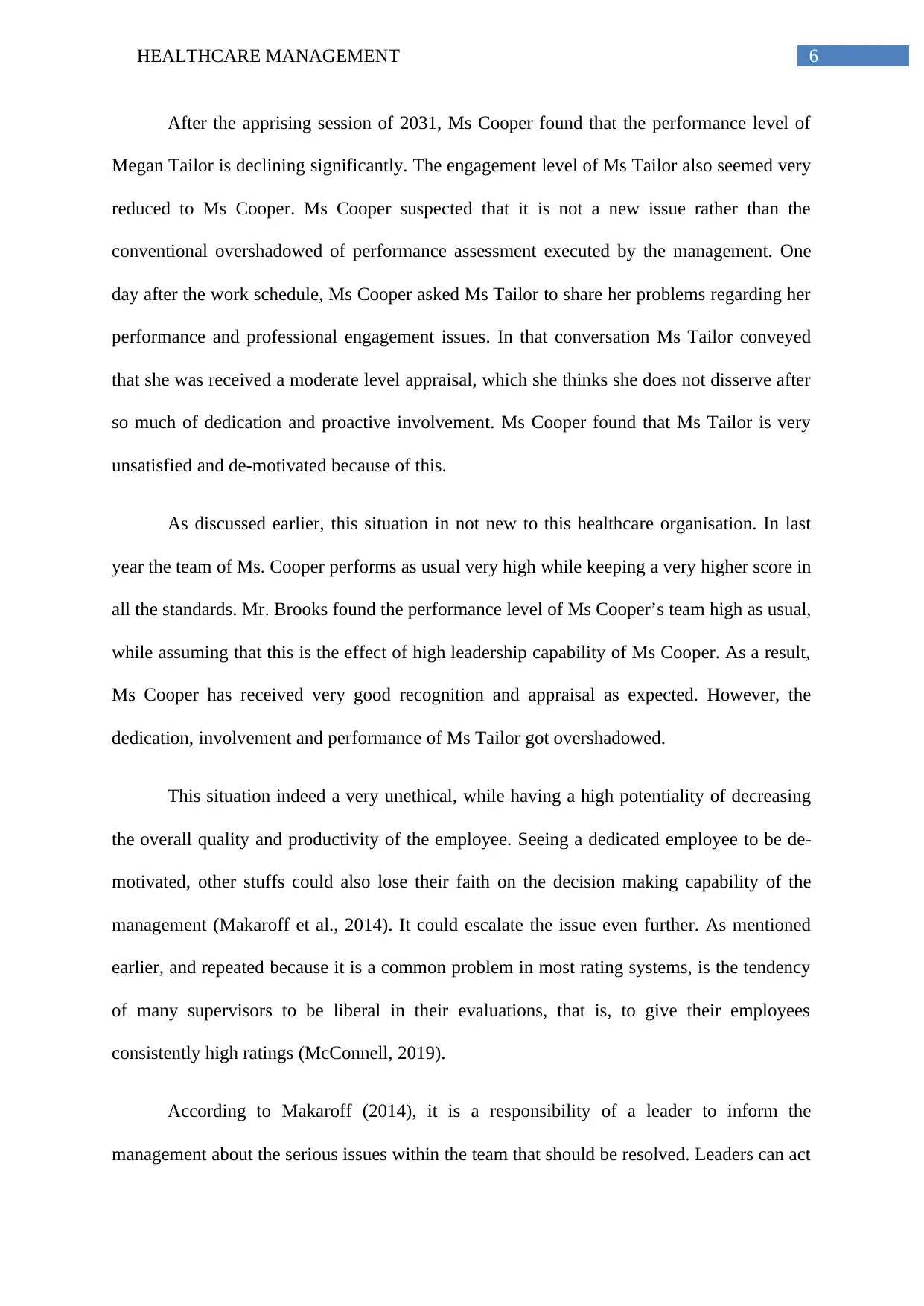
6HEALTHCARE MANAGEMENT
After the apprising session of 2031, Ms Cooper found that the performance level of
Megan Tailor is declining significantly. The engagement level of Ms Tailor also seemed very
reduced to Ms Cooper. Ms Cooper suspected that it is not a new issue rather than the
conventional overshadowed of performance assessment executed by the management. One
day after the work schedule, Ms Cooper asked Ms Tailor to share her problems regarding her
performance and professional engagement issues. In that conversation Ms Tailor conveyed
that she was received a moderate level appraisal, which she thinks she does not disserve after
so much of dedication and proactive involvement. Ms Cooper found that Ms Tailor is very
unsatisfied and de-motivated because of this.
As discussed earlier, this situation in not new to this healthcare organisation. In last
year the team of Ms. Cooper performs as usual very high while keeping a very higher score in
all the standards. Mr. Brooks found the performance level of Ms Cooper’s team high as usual,
while assuming that this is the effect of high leadership capability of Ms Cooper. As a result,
Ms Cooper has received very good recognition and appraisal as expected. However, the
dedication, involvement and performance of Ms Tailor got overshadowed.
This situation indeed a very unethical, while having a high potentiality of decreasing
the overall quality and productivity of the employee. Seeing a dedicated employee to be de-
motivated, other stuffs could also lose their faith on the decision making capability of the
management (Makaroff et al., 2014). It could escalate the issue even further. As mentioned
earlier, and repeated because it is a common problem in most rating systems, is the tendency
of many supervisors to be liberal in their evaluations, that is, to give their employees
consistently high ratings (McConnell, 2019).
According to Makaroff (2014), it is a responsibility of a leader to inform the
management about the serious issues within the team that should be resolved. Leaders can act
After the apprising session of 2031, Ms Cooper found that the performance level of
Megan Tailor is declining significantly. The engagement level of Ms Tailor also seemed very
reduced to Ms Cooper. Ms Cooper suspected that it is not a new issue rather than the
conventional overshadowed of performance assessment executed by the management. One
day after the work schedule, Ms Cooper asked Ms Tailor to share her problems regarding her
performance and professional engagement issues. In that conversation Ms Tailor conveyed
that she was received a moderate level appraisal, which she thinks she does not disserve after
so much of dedication and proactive involvement. Ms Cooper found that Ms Tailor is very
unsatisfied and de-motivated because of this.
As discussed earlier, this situation in not new to this healthcare organisation. In last
year the team of Ms. Cooper performs as usual very high while keeping a very higher score in
all the standards. Mr. Brooks found the performance level of Ms Cooper’s team high as usual,
while assuming that this is the effect of high leadership capability of Ms Cooper. As a result,
Ms Cooper has received very good recognition and appraisal as expected. However, the
dedication, involvement and performance of Ms Tailor got overshadowed.
This situation indeed a very unethical, while having a high potentiality of decreasing
the overall quality and productivity of the employee. Seeing a dedicated employee to be de-
motivated, other stuffs could also lose their faith on the decision making capability of the
management (Makaroff et al., 2014). It could escalate the issue even further. As mentioned
earlier, and repeated because it is a common problem in most rating systems, is the tendency
of many supervisors to be liberal in their evaluations, that is, to give their employees
consistently high ratings (McConnell, 2019).
According to Makaroff (2014), it is a responsibility of a leader to inform the
management about the serious issues within the team that should be resolved. Leaders can act
Paraphrase This Document
Need a fresh take? Get an instant paraphrase of this document with our AI Paraphraser
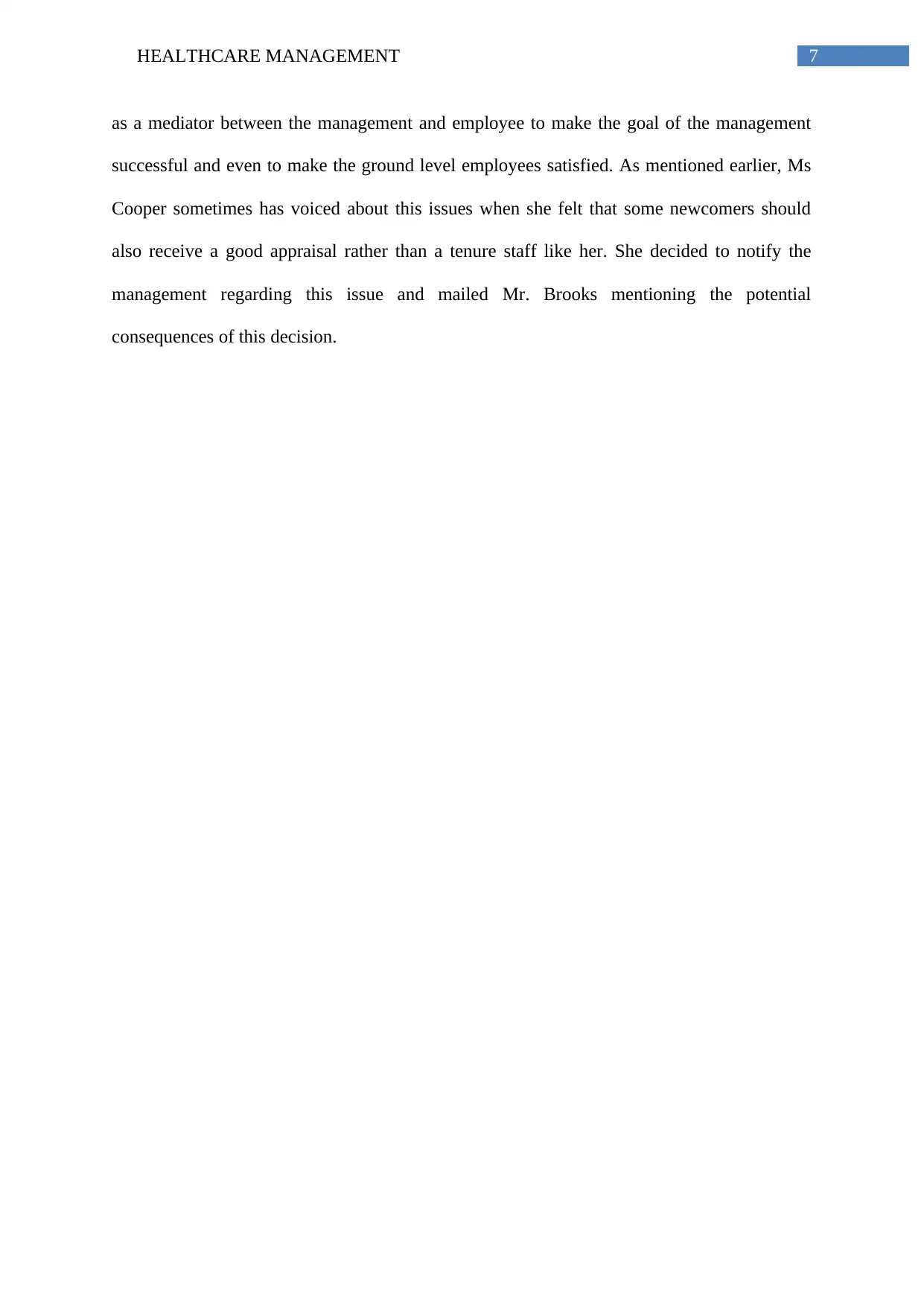
7HEALTHCARE MANAGEMENT
as a mediator between the management and employee to make the goal of the management
successful and even to make the ground level employees satisfied. As mentioned earlier, Ms
Cooper sometimes has voiced about this issues when she felt that some newcomers should
also receive a good appraisal rather than a tenure staff like her. She decided to notify the
management regarding this issue and mailed Mr. Brooks mentioning the potential
consequences of this decision.
as a mediator between the management and employee to make the goal of the management
successful and even to make the ground level employees satisfied. As mentioned earlier, Ms
Cooper sometimes has voiced about this issues when she felt that some newcomers should
also receive a good appraisal rather than a tenure staff like her. She decided to notify the
management regarding this issue and mailed Mr. Brooks mentioning the potential
consequences of this decision.
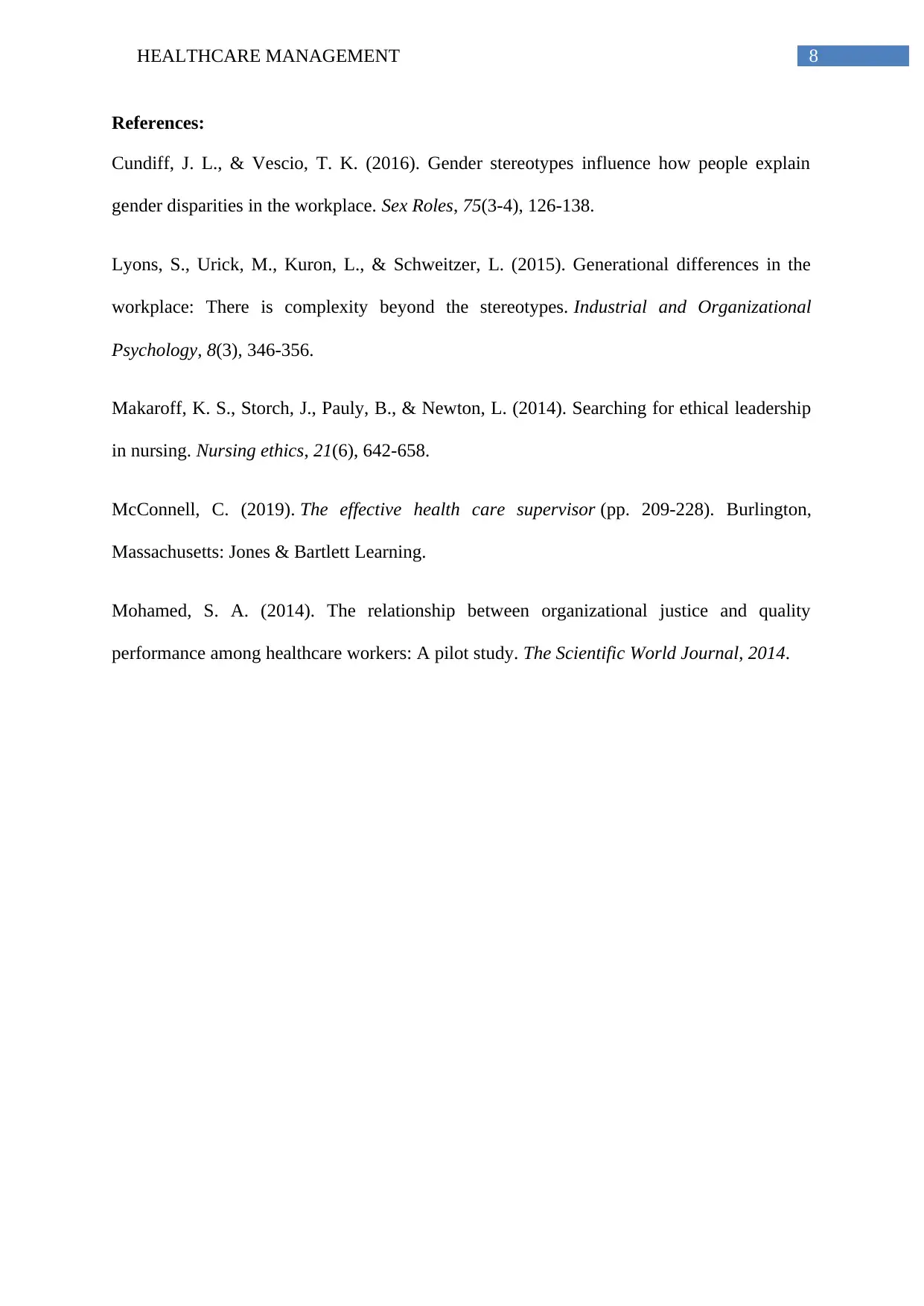
8HEALTHCARE MANAGEMENT
References:
Cundiff, J. L., & Vescio, T. K. (2016). Gender stereotypes influence how people explain
gender disparities in the workplace. Sex Roles, 75(3-4), 126-138.
Lyons, S., Urick, M., Kuron, L., & Schweitzer, L. (2015). Generational differences in the
workplace: There is complexity beyond the stereotypes. Industrial and Organizational
Psychology, 8(3), 346-356.
Makaroff, K. S., Storch, J., Pauly, B., & Newton, L. (2014). Searching for ethical leadership
in nursing. Nursing ethics, 21(6), 642-658.
McConnell, C. (2019). The effective health care supervisor (pp. 209-228). Burlington,
Massachusetts: Jones & Bartlett Learning.
Mohamed, S. A. (2014). The relationship between organizational justice and quality
performance among healthcare workers: A pilot study. The Scientific World Journal, 2014.
References:
Cundiff, J. L., & Vescio, T. K. (2016). Gender stereotypes influence how people explain
gender disparities in the workplace. Sex Roles, 75(3-4), 126-138.
Lyons, S., Urick, M., Kuron, L., & Schweitzer, L. (2015). Generational differences in the
workplace: There is complexity beyond the stereotypes. Industrial and Organizational
Psychology, 8(3), 346-356.
Makaroff, K. S., Storch, J., Pauly, B., & Newton, L. (2014). Searching for ethical leadership
in nursing. Nursing ethics, 21(6), 642-658.
McConnell, C. (2019). The effective health care supervisor (pp. 209-228). Burlington,
Massachusetts: Jones & Bartlett Learning.
Mohamed, S. A. (2014). The relationship between organizational justice and quality
performance among healthcare workers: A pilot study. The Scientific World Journal, 2014.
⊘ This is a preview!⊘
Do you want full access?
Subscribe today to unlock all pages.

Trusted by 1+ million students worldwide
1 out of 9
Related Documents
Your All-in-One AI-Powered Toolkit for Academic Success.
+13062052269
info@desklib.com
Available 24*7 on WhatsApp / Email
![[object Object]](/_next/static/media/star-bottom.7253800d.svg)
Unlock your academic potential
Copyright © 2020–2025 A2Z Services. All Rights Reserved. Developed and managed by ZUCOL.





